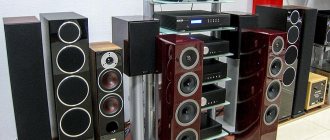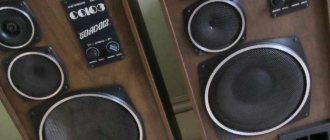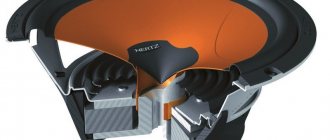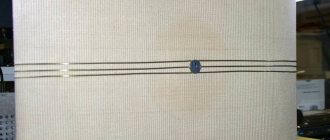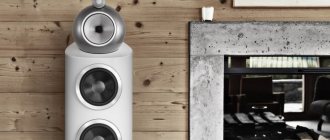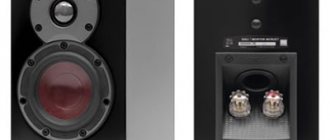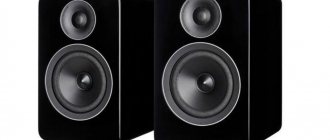For those who see the characteristics of acoustic systems for the first time and have never encountered this entire set of information before, one can only sympathize. At first glance, everything is complicated... Although, on the other hand, in order to figure it out, knowledge of a school physics course is quite enough.
Probably, everything will be simplified if we comment in order on the real set of characteristics, which, by the way, I would recommend obtaining from a proprietary document called Info Sheet. Such a PDF file can be downloaded from the website of almost any acoustics manufacturer for almost any of its models. It is there that, as a rule, everything is described most briefly and clearly.
Resistance or impedance
So, in order. Resistance or impedance. In some cases one thing is indicated, in others another, and there is a certain deceit in this. Yes, if we connect an ohmmeter to the speaker cable terminals, we will get the required 4, 6 or 8 ohms with an accuracy of ±10%. The only problem is that this measurement is incorrect: we are using direct current, but we are interested in the resistance to alternating current in the audio frequency range. And note: the voice coil of a speaker, by definition, cannot have linear (independent of frequency) electrical resistance - after all, it is inductance! And if we take into account that the speaker has resonant frequencies, and there are several such speakers in the column, plus all this is united by a completely nonlinear crossover circuit, then the DC resistance we measured becomes just an approximate figure.
Impedance (resistance) measurement graph
The correct parameter is impedance, which, as a rule, means resistance to alternating current - in our case, different at different frequencies. Most often, it is presented in the form of a graph of such a dependence. In serious speaker models, such a graph is often included. For speakers with an impedance of 8 ohms, at certain frequencies the impedance can “drop” threefold - say, to 2-3 ohms - and this can become a serious problem for the operation of the amplifier connected to the speaker. A more or less flat impedance curve of a multi-band system is a sign of a serious level of speaker development.
Tips for choosing
Several recommendations will help you make the right purchase and not regret your choice after a while:
- Decide on the sizes. Compact speakers are easy to carry, while large ones are best reserved for stationary use.
- Wireless speakers are more convenient to use because they do not have wires that always get tangled.
- If you want surround sound, then pay attention to the presence of a subwoofer.
- Speakers for a hi-fi player or home theater have many satellites that provide surround sound.
- The output power determines the maximum volume of the system.
- The closer the minimum frequency of the speakers is to 20, and the maximum to 20,000, the better and more pleasant the sound of the audio system will be.
- If you have a small workplace for permanent installation, then choose compact speakers.
Frequency range
The next parameter is the range of reproduced frequencies. If this paragraph says something like “35 Hz – 25 kHz” - and that’s it, then in this case I recommend immediately exclaiming something like the director’s “I don’t believe it!” Because this is yet another deceit, and it occurs quite often among sellers of inexpensive systems. Yes, our speaker can reproduce 35 hertz. But at this frequency its sensitivity (which, in this case, the manufacturer modestly kept silent about) can be very small. As a result, in this place (it is called the lower limit), the frequency response may have a “block” - a decrease in decibels by 20. And this, in turn, means that at this treasured low frequency, which is so important for reproducing “punch”, the speaker It sounds, it feels, 3-4 times quieter. That is, it is practically silent... The same applies to the upper limit frequency of the range.
An example of measuring the frequency response of acoustics
The frequency range indicated in the technical specifications will look correct only in combination with an indicator of the unevenness of the frequency response in decibels throughout this range. And data like “frequency range 35 Hz – 25 kHz with unevenness ±3 decibels” immediately evokes respect and a serious attitude towards the product. It is optimal if in the documentation this data is illustrated by a graph of the frequency response - amplitude-frequency characteristic, where frequency is plotted along the horizontal axis, and sound pressure is plotted along the vertical axis.
An important, although not so common, is the indication of the frequency range and its unevenness when deviating from the axis by an angle, usually 15-30 degrees. This parameter allows you to evaluate how wide the directionality of the speakers' sound is. In particular, the size of the surround sound “spot”—the area in which listeners will receive a high-quality spatial effect—depends on it. This, in turn, determines how many “seats” can be located in the auditorium formed by new speakers in a particular room, which is especially important not only for classic stereo, but also when using acoustics in home theater systems.
TOP 7 best computer speakers
Having analyzed a large number of models on sale, we included the following columns in the rating:
- Logitech G G560;
- Harman Kardon SoundSticks Wireless;
- Defender Aurora S20;
- Aceline ASP300;
- Microlab B56;
- Genius SW-2.1 370;
- DEXP T100.
Let's get to know each of the listed models in more detail.
Logitech G G560
The ranking of the best speakers opens with a stylish design, high-quality sound at any frequency and powerful bass without interference. The subwoofer type is passive, and this will especially please those who prefer heavier music. Thanks to this type, the device can produce richer and deeper bass. With multi-colored speaker lighting, creating a festive mood will be even easier.
| Dimensions | 255x404x207 mm |
| Weight | 5.5 kg |
| Subwoofer power | 60 W |
| Diffuser diameter | 40 Hz |
Price: from 14,000 to 16,000 rubles.
pros
- power of each speaker - 10 W;
- provides connection to other devices via Bluetooth;
- unusual design with multi-colored lighting.
Minuses
- The software sometimes freezes.
I bought it a month ago. I use it every day to listen to music and watch movies. They completely cope with their task. The sound is high quality and spacious. You can connect to other devices over the network without using a special cable. Excellent purchase!
Logitech G G560
Harman Kardon SoundSticks Wireless
The speakers are equipped with a 160 mm subwoofer, eight full-range speakers, a 40 W amplifier, touch-sensitive volume and mute controls, as well as a 3.5 mm jack for connecting various audio devices.
| Front speaker power | 2×10 W |
| Housing material | plastic |
| Subwoofer power | 20 W |
| Diffuser diameter | 152 mm |
Price: from 9,000 to 11,000 rubles.
pros
- Bluetooth technology is supported;
- no wires;
- light weight (2.2 kg).
Minuses
- cannot be used with Apple products.
Light weight makes it easy to carry from place to place. Compact dimensions do not cause discomfort in use. They don't take up much space on the shelf. The big advantage is the complete absence of wires. This eliminates the possibility of cable tangling.
Harman Kardon SoundSticks Wireless
Defender Aurora S20
The total power of the speakers is equal to 20 W. They reproduce an impressive range of frequencies, ranging from 20 Hz to 20,000 Hz. Low frequencies (bass) can be adjusted, which is one of the main advantages of these speakers. The speakers are powered by a standard 220 V household network. The design has a line input as well as a headphone jack. The speakers are equipped with magnetic shielding.
Sensitivity
In connection with all of the above, let’s move on to the “sensitivity” parameter. It is measured in decibels. This indicator, to some extent, indicates the degree of perfection of our column. In practice, this is its efficiency, its efficiency factor. For modern acoustics, this parameter is in the range of about 83-95 decibels. It is clear that high sensitivity values, especially for a classical multiband system, are achieved through many serious and often expensive technological improvements.
Speaker sensitivity measurement circuit
Increasing sensitivity by 6 decibels leads to the feeling that, with the same input signal, the acoustics sound approximately twice as loud! And by the way, in order to raise the volume by 3 decibels, the speaker cone must vibrate with approximately twice the amplitude. For a low-power amplifier, and this, in particular, is the majority of tube models, the sound of which is so attractive, you need acoustics with high sensitivity.
Maximum sound pressure
In the technical parameters of user acoustics (as opposed to professional models), this indicator is rarely indicated. Maximum sound pressure is naturally also measured in decibels and can obviously be indirectly calculated from sensitivity and maximum power data.
Without deliberately delving into the details and conditions for measuring these parameters, we will only say that in order to obtain the full set of impressions from audio, a limit of 90 dB is considered more or less established - at this volume (fixed, as a rule, a meter from the emitter, at that time , as listeners are located much further away), many test reports recommend performing a listening test. For comparison, sets of disco equipment for halls operate at levels up to 130 (tops) – 140 (subs) dB. This is a level approaching the pain threshold. Serious home speakers, on average, produce a maximum of 100-110dB, and for goodness sake, have pity on your neighbors!
Comparison of models
We present to your attention a table with the main technical parameters of the previously described columns. With its help, you can visually compare several models you like.
| Model name | Power, W) | Weight, kg) | Dimensions (mm) | Cost, rub) |
| Logitech G G560 | 60 | 5.5 | 255x404x207 | 14 000 – 16 000 |
| Harman Kardon SoundSticks Wireless | 20 | 2.2 | 232x258x232 | 9 000 – 11 000 |
| Defender Aurora S20 | 20 | 2 | 210x245x230 | 1 500 – 2 000 |
| Aceline ASP300 | 10 | 2.1 | 126x220x130 | 1 000 – 1 500 |
| Microlab B56 | 10 | 1.2 | 63x160x107 | 1 000 – 1 400 |
| Genius SW-2.1 370 | 8 | 0.9 | 120x132x175 | 1 000 – 1 300 |
| DEXP T100 | 11 | 1 | 115x145x170 | 2 000 – 2 500 |
Harmonic distortion factor
This is a very important characteristic, which, however, also rarely appears in the speaker parameters. Methods for measuring it are not entirely correct. And yet, for high-quality models it does not exceed one percent; for good-quality speakers it is a third of a percent (0.32% - 0.37%) in almost the entire frequency range, and only at the bottom this parameter can exceed 1 percent. If we consider that it is at low frequencies that our ears are not very susceptible to distortion, then such a “jump” is not critical.
Another feature: the THD increases sharply at high volumes. It should be understood that in the audio path "source - intercom cable - preamplifier - intercom cable - final amplifier - speaker cable - speaker", it is the speaker system that is the source of the most serious distortions, although it would probably be worth talking about distortions in more detail in connection with amplifiers.
Sound Frequency Chart for Musical Instruments from Sound On Sound
The sound frequency table consists of two parts. The first part is an Instrument Frequencies , which provides information about the frequency ranges of a number of common musical instruments. Instruments are divided into five groups - human voice, percussion instruments, guitar and bass, strings, and wind instruments. Additionally, the diagram reflects the sound ranges of the given instruments, for which the illustration is supplemented with a list of octaves and the names and frequencies of the sounds included in them.
Sound frequency table. Screenshot of the first part.
The second part - “Subjective nature of sound” - is a table that shows the main frequencies for equalizing popular musical instruments, as well as comparative descriptions of these frequencies. The information in the table clearly shows how to make the sound of popular instruments sharper, sharper, clearer, or more intelligible.
At the same time, the creators note that they did not strive to create a comprehensive guide to equalization, but wanted to create a visual guide that would help musicians and sound engineers when recording and mixing music.
Sound frequency table. Screenshot.
The editors of SAMESOUND.RU translated and adapted the texts in the table, and also made a number of explanatory additions. The audio frequency chart is distributed as a PDF file that is ready to print in high resolution. The document contains cut margins and other information useful to printers. Note that it is better to print the table in A3 format, since when printing on A4 sheet, the legibility of the content is lost due to the abundance of small text.
Frequency_chart_SAMESOUNDRU-hires-1-0-19.zip – Downloaded 9611 times – 1 MB
